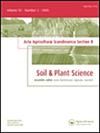旱季自养和异养土壤呼吸在农业生态环境中的对比
IF 1.8
4区 农林科学
Q2 AGRONOMY
Acta Agriculturae Scandinavica Section B-Soil and Plant Science
Pub Date : 2023-03-20
DOI:10.1080/09064710.2023.2189613
引用次数: 0
摘要
本文章由计算机程序翻译,如有差异,请以英文原文为准。
Dry-season autotrophic and heterotrophic soil respiration in contrasting agroecological settings
ABSTRACT In arid Africa, it is unclear how the transition from grassland to cropland affects CO2 fluxes and whether these effects are climate-dependent. From November 2019 to March 2020 (dry season), we studied autotrophic (Ra) and heterotrophic (Rh) soil respiration. At highlands, grazing land (1.18 ± 0.13 µmol m−2 s−1) and teff croplands (1.36 ± 0.14 µmol m−2 s−1) had the lowest Rh, while acacia decurrens plantations (1.94 ± 0.19 µmol m−2 s−1) were the largest. When compared to teff (2.08 ± 0.20 µmol m−2 s−1) and khat (1.73 ± 0.24 µmol m−2 s−1), grazing land in the midland had a lower Rh (1.18 ± 0.13 µmol m−2 s−1). Ra on teff (1.51 ± 0.27 µmol m−2 s−1) was substantially (P < 0.05) greater than on grazing land (1.08 ± 0.32 µmol m−2 s−1) in the highlands. Grazing lands (1.54 ± 0.21 µmol m−2 s−1) have a considerably (P < 0.05) greater Ra than farmlands (teff, 0.20 ± 0.07 µmol m−2 s−1; groundnut, 0.09 ± 0.03 µmol m−2 s−1) in lowlands. Growing teff in the highlands and midlands will result in higher CO2 fluxes into the atmosphere. However, in-depth research is needed to implement effective land management that reduces CO2 emissions.
求助全文
通过发布文献求助,成功后即可免费获取论文全文。
去求助
来源期刊
CiteScore
4.40
自引率
0.00%
发文量
56
审稿时长
2.3 months
期刊介绍:
Acta Agriculturæ Scandinavica Section B publishes original research in applied soil and plant science with special attention given to to crop production in agri- and horticultural systems. We welcome manuscripts dealing with:
Climate smart and sustainable crop production systems
Water and nutrient efficiency
Soil conservation and productivity
Precise agriculture systems
Applications of bio- and nanotechnology
Digitalisation and robotics
Soil-plant interactions
Acta Agriculturæ Scandinavica, Section B – Soil & Plant Science forms part of a series of titles published on behalf of the Nordic Association of Agricultural Science (NJF). The series also includes Section A - Animal Science .

 求助内容:
求助内容: 应助结果提醒方式:
应助结果提醒方式:


